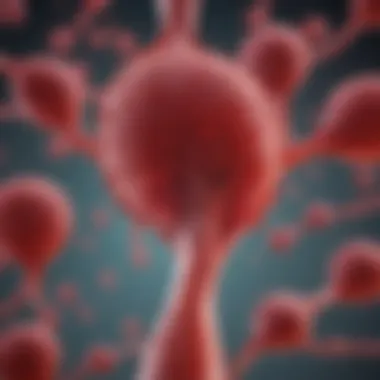Exploring Thalassemia: Curability and Future Directions


Article Overview
Thalassemia is a serious inherited blood disorder that has captured the attention of medical professionals and researchers alike. This article explores the complexities involving thalassemia's curability. It aims to provide a clear understanding of current medical treatments, recent advancements in gene therapy, and the influence of lifestyle changes on managing the condition. Moreover, it delves into ongoing research pursuits and the potential future therapies that may lead to more definitive solutions for those affected by thalassemia.
Purpose of the Article
The primary purpose of this article is to assess the current landscape of thalassemia treatment options and to evaluate their efficacy in terms of curability. It presents a thorough examination of both traditional and innovative therapeutic approaches. An emphasis on emerging research indicates areas where significant progress may be achieved. This article serves to illuminate the complex interplay between genetics and therapy, which is crucial for understanding how thalassemia can be managed or potentially cured.
Relevance to Multiple Disciplines
Thalassemia is not only a matter of hematology. Its implications stretch across several disciplines, including genetics, pharmacology, and epidemiology. Medical professionals need to stay informed about the evolving treatments to provide the best care for patients. Genetic counselors play an essential role in informing families about their risks and potential outcomes. Additionally, researchers in biotechnology and pharmaceutical fields work collaboratively to unlock new therapies. Thus, this article is valuable to a wide array of audiences, including students, healthcare professionals, and researchers.
Research Background
Understanding thalassemia requires delving into both its historical context and fundamental concepts.
Historical Context
Thalassemia has a rich history, with its recognition dating back to the early 1920s. The condition was first described in Mediterranean populations, where it was seen as a public health problem. As more was learned about the disease's genetic basis, the scientific community began to develop targeted therapies, such as blood transfusions and chelation therapy. Recent decades have witnessed the development of gene therapy options aimed at addressing the underlying genetic causes of the disorder.
Key Concepts and Definitions
Thalassemia encompasses a spectrum of genetic disorders that result in reduced production of hemoglobin. It stems from mutations in the genes responsible for hemoglobin synthesis. While it can cause severe anemia and related complications, understanding its types—Alpha and Beta thalassemia—is essential. Each variant manifests differently, influencing patient management strategies.
- Alpha Thalassemia: Caused by deletions of the alpha globin gene, leading to varying degrees of anemia.
- Beta Thalassemia: Results from mutations affecting the beta globin gene and can lead to severe forms that require regular blood transfusions.
This foundational knowledge is pivotal in discussing treatment modalities, current research advancements, and ultimately assessing the curability of thalassemia.
Prolusion to Thalassemia
Thalassemia is a significant area of focus in hematology, being one of the most common inherited disorders affecting hemoglobin synthesis. Understanding this topic contributes substantially to the overall discourse on blood health and genetic conditions. The article underscores the importance of identifying thalassemia's nuances through its various dimensions, including pathophysiology, current treatments, and future directions of research.
Exploring thalassemia offers insights into not only the disease mechanism but also the socio-economic implications it brings to affected populations. This knowledge can inform medical professionals, researchers, and policy-makers alike. Additionally, it aids patients and families in understanding the nature of the disease, leading to better management strategies.
Thalassemia's diverse characteristics warrant a closer examination of its types, prevalence, and treatment options, revealing critical paths toward curability. This article will unravel the complexities associated with thalassemia, focusing on emerging therapies and current practices that shape patient outcomes.
Understanding the Pathophysiology of Thalassemia
Understanding the pathophysiology of thalassemia is vital in grasping the complexities of this condition. Knowledge of how thalassemia develops helps healthcare professionals design effective treatments and management strategies. This understanding highlights the genetic nature of thalassemia and the consequences of altered hemoglobin production. By examining the fundamental mechanisms of the disease, we gain insights into its symptoms, complications, and potential avenues for research that can improve patient outcomes.
Genetic Basis of Thalassemia
Thalassemia is primarily a genetic disorder, resulting from mutations in the genes responsible for hemoglobin production. These mutations lead to insufficient or defective hemoglobin chains, disrupting normal blood function. Individuals can inherit thalassemia either as a recessive trait or through more complex genetic interactions. The most common genes involved are HBA1 and HBA2, which code for alpha-globin, and HBB, relating to beta-globin.
Understanding the genetic basis not only aids in diagnosis but also informs genetic counseling, allowing families to make educated choices about reproduction and screening. This genetic knowledge lays the groundwork for innovative treatments like gene therapy, which aims to correct the underlying mutations causing the disease.
Implications of Abnormal Hemoglobin Production


Abnormal hemoglobin production leads to several physiological issues. Insufficient hemoglobin levels result in anemia, characterized by fatigue, weakness, and pallor. The body tries to compensate for this anemia by increasing red blood cell production, often resulting in an enlarged spleen. This enlargement, known as splenomegaly, can further complicate clinical management.
Another implication is the reduced oxygen-carrying capacity of the blood, which affects tissue oxygenation. This can lead to serious complications like heart problems and stunted growth in children. Recognizing these implications is essential for effective monitoring and treatment, enhancing the quality of life for individuals with thalassemia.
Symptoms and Complications
The symptoms and complications of thalassemia vary considerably among patients. Understanding these aspects enriches the overall approach to managing this disorder.
Physical Symptoms
Thalassemia presents with diverse physical symptoms. The most prominent include fatigue, pallor, and jaundice. Fatigue arises from chronic anemia, while pallor results from reduced hemoglobin concentrations. Jaundice occurs due to the increased breakdown of red blood cells. These symptoms together define the physical experience of the disease. They help clinicians assess the severity and tailor interventions accordingly.
The unique feature of physical symptoms is their varied expression among individuals. Some may experience mild symptoms, while others exhibit severe manifestations. This variability poses challenges in treatment but also underscores the need for personalized management strategies that consider each patient's unique clinical picture.
Long-Term Complications
Thalassemia's long-term complications can significantly impact a patient's life. These complications often include iron overload due to repeated blood transfusions, which can damage organs such as the liver and heart. Other complications involve bone deformities and delayed growth, particularly in children and adolescents.
The key characteristic of these long-term complications is their potentially life-threatening nature. They necessitate ongoing medical care and monitoring. This underscores the importance of early detection and comprehensive management. A proactive approach can prevent or mitigate many of these complications, thus enhancing patient quality of life.
Understanding the pathophysiology of thalassemia deepens our knowledge of disease mechanisms, guiding better treatment and management options.
Understanding the pathophysiology of thalassemia deepens our knowledge of disease mechanisms, guiding better treatment and management options.
Current Treatment Options for Thalassemia
Thalassemia management is a critical focus within the broader context of this inherited disorder. As individuals affected by thalassemia face numerous physical and emotional challenges, understanding the various treatment options can greatly enhance their quality of life. Current treatment choices aim not just to alleviate symptoms, but to improve overall health and well-being. This section will explore key options available to those living with thalassemia, emphasizing their importance, benefits, and any necessary considerations.
Blood Transfusion Therapy
Blood transfusion therapy is fundamental for managing thalassemia, particularly for beta-thalassemia patients. This procedure involves the regular infusion of healthy red blood cells to combat anemia, a common condition in those with thalassemia. By elevating hemoglobin levels, blood transfusions help in preventing serious complications, such as heart failure and severe fatigue.
However, repeated blood transfusions can lead to an excess of iron in the body, known as secondary hemochromatosis. This condition can damage organs, necessitating additional interventions. Regular monitoring of hemoglobin levels and iron overload is essential to manage this risk effectively.
Iron Chelation Therapy
To address the iron overload caused by blood transfusions, iron chelation therapy is crucial. This treatment involves the administration of medications that bind free iron in the bloodstream, allowing for its removal from the body. Two prominent chelating agents are deferoxamine and deferasirox. These drugs improve an individual's iron metabolism and reduce levels of deposited iron in the organs.
It's vital for patients to adhere strictly to their chelation regimens. Non-compliance can result in serious health risks, including organ failure. Regular assessments are necessary to ensure that iron levels remain within a safe range.
Folic Acid Supplementation
Folic acid plays an essential role in the production of red blood cells. Patients with thalassemia often have increased folate demands due to hemolysis—the breakdown of red blood cells. Folic acid supplementation can help meet these demands, thereby enhancing red blood cell production. While this treatment does not directly address the underlying genetic issue, it serves to complement other therapies, promoting better health outcomes.
Patients should consult with healthcare providers to determine appropriate dosages and monitor any potential side effects. Regular follow-up is essential to assess the effectiveness of supplementation.
"The approach to treating thalassemia often requires a multi-faceted strategy, combining various therapies to achieve optimal management."


"The approach to treating thalassemia often requires a multi-faceted strategy, combining various therapies to achieve optimal management."
Investigating the Curability of Thalassemia
The investigation into the curability of thalassemia is a pivotal aspect of modern hematology. This condition, which leads to significant morbidity due to its genetic nature, has seen a surge in research that aims to provide definitive curative options. Understanding the various avenues explored for curing thalassemia not only enhances the knowledge pool within the medical community but also fosters hope among patients and families impacted by this disease. The examination of gene therapy, stem cell transplantation, and emerging therapeutic options reflects a multi-faceted approach that is essential in addressing the complexities of thalassemia.
Gene Therapy for Thalassemia
Gene therapy represents a groundbreaking shift in the treatment paradigm for thalassemia. This intervention aims to correct the underlying genetic defect responsible for the disorder. By introducing a normal copy of the gene that is deficient or mutated in thalassemia, researchers aspire to restore proper hemoglobin production. The potential of gene therapy lies in its ability to provide a long-term solution that could alleviate the need for regular blood transfusions and related complications.
Stem Cell Transplantation
Stem cell transplantation is another promising avenue for potentially curing thalassemia. This technique involves replacing the defective bone marrow of the patient with healthy stem cells from a compatible donor.
Eligibility Criteria
The eligibility criteria for stem cell transplantation are crucial in determining which patients can benefit from this procedure. Typically, younger patients with a matched donor and a severe form of thalassemia tend to be prime candidates. Factors such as overall health, degree of disease severity, and availability of donor match significantly influence eligibility. This careful selection process is vital because it enhances the likelihood of successful outcomes while minimizing the risks associated with transplantation.
Success Rates
Success rates for stem cell transplantation have improved over recent years but remain variable. Generally, the likelihood of a successful outcome increases when performed on younger patients with fewer health complications. Factors such as the source of the stem cells—whether from bone marrow, peripheral blood, or umbilical cord blood—can also affect success rates. Assessing success rates provides valuable insight into the effectiveness of this treatment approach, aiding clinicians in making informed decisions regarding treatment plans.
Emerging Therapies and Research
Ongoing research is critical as it continues to unveil new therapies and better understanding of existing treatments. Innovations such as gene editing and novel pharmacologic agents are on the frontier of thalassemia treatment and management.
CRISPR Technology
CRISPR technology has gained attention for its potential application in correcting genetic mutations associated with thalassemia. This method allows for precise editing of the gene that produces hemoglobin, making it a powerful tool in the fight against genetic disorders. The precision of CRISPR not only enhances the prospects of successful correction but also reduces the chances of off-target effects that could lead to unintended consequences. Its adaptability in addressing different forms of thalassemia makes it a serious candidate for future research and therapy.
Novel Drugs in Clinical Trials
Novel drugs currently under clinical trials are also being investigated for their efficacy in managing thalassemia. These agents may provide alternative supportive therapies that reduce the burden of blood transfusions or iron overload, a significant complication from current treatment regimens. Their development signifies the continuous effort to refine treatment strategies and enhance the quality of life for thalassemia patients.
Research into these emerging therapies highlights an exciting future, potentially revolutionizing the treatment landscape for thalassemia.
Lifestyle and Management Strategies
Lifestyle and management strategies play a critical role in the overall well-being of individuals living with thalassemia. While medical treatments address the biological aspects of the condition, incorporating lifestyle changes can vastly improve the quality of life. Management strategies encourage patients to take an active role in their health while also providing support systems that foster emotional resilience.
The interconnection between lifestyle and health is evident in chronic diseases like thalassemia. Managing dietary habits, emotional health, and psychological support are essential components that complement medical therapies. Engaging in these strategies can lead to improved compliance with treatment protocols, reduced complications, and a better emotional state for patients.
Dietary Considerations
Dietary considerations are fundamental for individuals dealing with thalassemia. A balanced and nutritious diet can address specific needs that arise from the disorder while mitigating some common complications. Patients often experience iron overload due to repeated blood transfusions. Hence, careful dietary management is necessary.
Specific recommendations include:


- Limit Iron-Rich Foods: Foods like red meat, organ meat, and fortified cereals can contribute to excess iron. Monitoring intake of these items is crucial.
- Increase Antioxidants: Consuming fruits and vegetables rich in vitamins C and E can help manage oxidative stress, which may be elevated due to the condition.
- Folate Intake: Folic acid is vital for hemoglobin production. Leafy greens, legumes, and fortified foods can help meet this need.
- Stay Hydrated: Maintaining hydration supports overall health and assists in managing potential constipation related to some iron chelation therapies.
By prioritizing dietary considerations, patients not only mitigate certain risks but also empower themselves through knowledge and food choices.
Emotional and Psychological Support
Emotional and psychological support is equally significant for patients living with thalassemia. The psychological burden can be considerable, impacting daily life and treatment adherence. Support systems can help in coping with the emotional challenges that often accompany chronic illnesses.
Support can come from various sources:
- Counseling Services: Professional mental health services can provide coping strategies tailored to individual experiences with thalassemia.
- Support Groups: Connecting with others facing similar challenges provides a sense of community, helping individuals share experiences and coping mechanisms.
- Education: Learning about the condition empowers patients, reducing anxiety related to the unknown aspects of their health.
- Mindfulness Practices: Techniques such as meditation, yoga, or deep-breathing exercises can enhance emotional health and decrease stress levels.
"A well-rounded support system enhances resilience among patients, leading to improved adherence to treatments and overall well-being."
"A well-rounded support system enhances resilience among patients, leading to improved adherence to treatments and overall well-being."
Emotional and psychological support should not be underestimated. When incorporated alongside dietary strategies and medical therapies, these practices foster a holistic approach to managing thalassemia effectively.
Future Directions in Thalassemia Research
The realm of thalassemia research has evolved significantly in recent years. Understanding the future directions in this field is essential for multiple reasons. First, it indicates a continuous effort to improve treatment and management options. As scientists probe deeper into the genetic underpinnings of thalassemia, better therapies may emerge. Second, advancements can lead to enhanced quality of life for those affected by the disorder. The focus on future research will likely center on curative strategies and innovative therapies, establishing a hopeful narrative for patients and advocates alike.
Trends in Genetic Research
Genetic research is at the forefront of thalassemia advancements. Knowledge about the genetic mutations that cause thalassemia is expanding. Advances in technology, including whole-genome sequencing, are allowing researchers to identify specific mutations with greater precision. The exploration of the human genome has opened avenues for understanding not only thalassemia itself but also other related disorders.
Furthermore, research into gene editing technologies such as CRISPR is gaining momentum. The potential to correct genetic defects that lead to thalassemia could change how future generations experience this condition. Such technologies may not only provide new treatment options but also pave the way for preventative measures in future patients.
Potential Breakthroughs and Innovations
Several potential breakthroughs are on the horizon that could revolutionize how thalassemia is treated. One noteworthy area involves the continued development of gene therapy. While initial trials show promise, ongoing studies are refining techniques to enhance efficacy and reduce risks. Innovations in delivery methods are also crucial, as effective gene therapies must reach specific cells in the body.
Additionally, the role of artificial intelligence in analyzing genetic data is becoming critical. AI and machine learning can help identify patterns and predict outcomes, ultimately guiding more personalized treatment plans. By harnessing these technologies, researchers aim to create solutions that are tailored for individual patients, ensuring more effective interventions.
As the field progresses, the integration of new scientific methods and collaborative efforts among researchers worldwide will be fundamental.
As the field progresses, the integration of new scientific methods and collaborative efforts among researchers worldwide will be fundamental.
In summary, the future of thalassemia research appears promising. The combination of genetic studies, advanced therapies, and innovative technologies could provide the foundational changes needed to enhance the lives of those living with thalassemia.
Epilogue
The topic of thalassemia's curability is both significant and multifaceted. As thalassemia continues to affect millions globally, understanding the current medical landscape, potential breakthroughs, and management strategies plays a crucial role not only for patients but also for health professionals advising them.
Summary of Key Points
The examination of thalassemia has revealed several essential elements:
- Genetic Basis: The inherent genetic components define the disorder's nature, impacting treatment plans. A clear grasp of these genetics is indispensable for advancing treatment and curability prospects.
- Current Treatments: Various existing treatments such as blood transfusion and iron chelation therapy provide symptomatic relief yet do not cure the underlying genetic defect.
- Emerging Technologies: Innovations, notably in gene therapy, suggest a pathway towards potential cures. Ongoing research in this domain could redefine the management of this blood condition, offering hope for a more definitive resolution.
- Future Directions: The exploration into new therapies and the integration of lifestyle changes manifest the comprehensive approach required to tackle thalassemia comprehensively.
Looking Ahead
The future of thalassemia management and potential cure lies in several promising directions:
- Advancements in Gene Therapy: Continued research into gene editing techniques, like CRISPR, presents opportunities for developing therapies that could correct the genetic mutations associated with thalassemia.
- Innovative Clinical Trials: The ongoing clinical trials for novel drugs can supplement existing treatment options, aiming for improved efficacy and safety. Understanding results from these trials will inform future treatment protocols.
- Interdisciplinary Collaboration: There is a rising need for collaboration between geneticists, clinicians, and researchers to facilitate a holistic approach towards care for individuals with thalassemia. This interdisciplinary strategy can enhance research outcomes and provide comprehensive care to patients.



